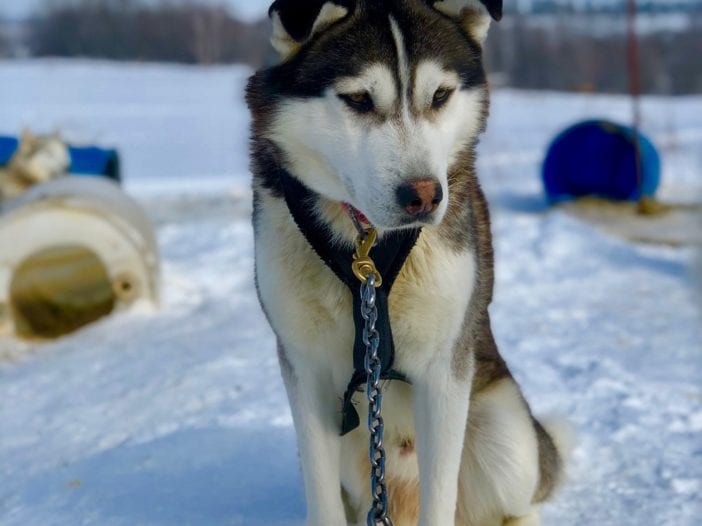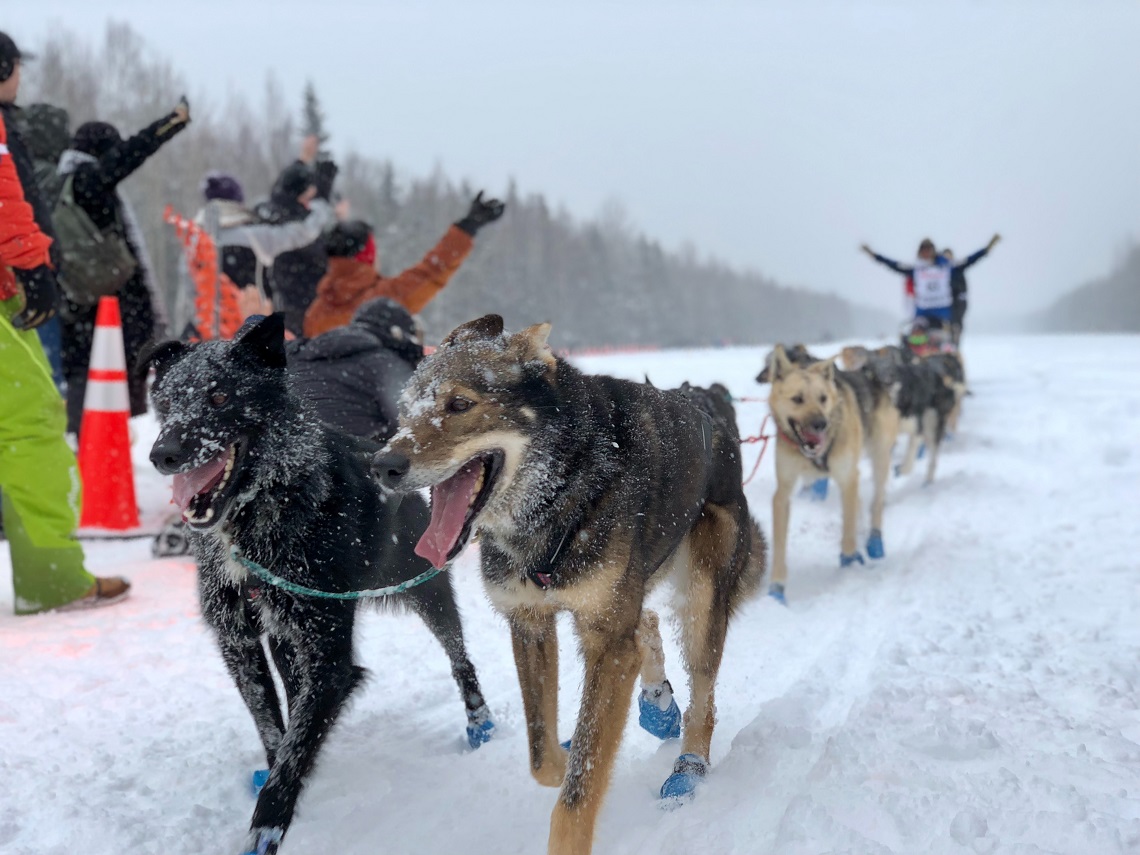
The Iditarod Is Cruel & Dangerous
As an author, Certified Dog Behavior Consultant (CDBC) and Certified Professional Dog Trainer (CPDT), I feel compelled to respond to a recent article about Dorada, an Alaskan Husky who recently dropped dead because of the Iditarod dog sled race.
Author Mark Derr of Psychology Today defends the race in his best attempt at prose. One must ask, why?
The Iditarod Dog Sled Race Kills Dogs In The Name Of Tradition
Do we really need dogs to die to see how dangerous and unnecessary a dog sport or tradition is? Just how inhumane does a race need to be for an author to condemn this tradition? There is a reason the Humane Society of the United States and a plethora of other animal rights organizations have publicly condemned the Iditarod race as inherently cruel to dogs, and I’m not sure where the ambiguity lies.3 The Iditarod is an extreme sport by any measure. And dogs should not be involved in extreme sports for our pleasure.
Although Derr asks some provoking questions, the overall tone was clearly supportive of the Iditarod Dog Sledding race. You would think that author and historian Derr would be a supporter of animal rights, but after reading his recent blog post in Psychology Today, it doesn’t seem that way. Derr romanticizes the inhumane and cruel Iditarod Dog Sledding race with passages such as “The Iditarod Trail Sled Dog Race…has made heroes of the dogs and men and women who have run and won it, including the late Susan Butcher, a four-time champion with her great lead dog, Granite.“ “Heroes?” My diction would be profoundly different. Dogs do not understand the concept of “hero” any more than any other or our social mores or conventions.
Instead of condemning the cruel practices for tradition and the sake of the human ego, Derr’s tone celebrates and glorifies the Iditarod and its “virtues and long history” as some perverse confirmation of its existence. Instead of deriding the race and defending the animal activists he does precisely the opposite and reveres and defends the race and refutes the animal activists.
One must wonder why an author who clearly has little love or care for the humane treatment of animals is writing under the “animal” column for Psychology Today?
In the article, Derr mentions PETA often. Mentioning PETA and their better off dead philosophy, and citing their statistics, moral sway, and hypocritical ways without a caveat and disclaimer is like mentioning Cesar Millan without one as well- unethical and immoral.
PETA’s outright denial and opposition of companion animals and PETA’s record of killing are astoundingly shameful. To quote PETA about the ethical treatment of companion animals is akin to quoting Cesar Millan or Michael Vick on the science of force-free, fear-free, positive reinforcement dog training and behavior and the ethical, humane treatment of animals. Oxymorons and paradoxes don’t get much grander than this. But I digress.
I think it gets a little old and disingenuous when confused journalists and authors opine about every subject under the sun. I do not proclaim my acuity or try to speak intelligently about animal medical issues. Although I know a great deal about medical issues, I am not a medical doctor, and do not write about them, nor should dog-loving authors try and play veterinarian through their writings.
To quote Derr, “I investigated the charges for the Atlantic Monthly in 1995—‘The Perilous Iditarod’—and concluded that the fundamental charge that the dogs were made to run, even to death, was untrue.” Did he conclude this because he is a veterinarian, a behaviorist, or has an advanced degree that would give him some knowledge of this fact? Perhaps he was at this race and had some empirical evidence that no one else knows about?
What evidence is Derr’s conclusion based off of and ironically enough, how could this be untrue when it has just happened in the Iditarod that just took place and at many others?
Derr goes on to state, “Anyone who knows about dogs knows that when they have had enough, they stop. They go on strike, and no amount of whacking is going to make them go. The quitting point is different for different dogs.” I retort, as a fellow blogger, esteemed author, and animal activist Dr. Marc Bekoff did as well “While no dogs are known to have died from 2009-2012, it’s extremely important to consider how much dogs suffer even if they don’t die. For some, death might be a blessing.”
Irresponsible Dog Journalism
Irresponsible journalism is nothing new. We have called out many authors. Derr is no different. he goes on to state only half-truths with this quote: “Anyone who knows about dogs knows that when they have had enough, they stop.” True, but as anyone who knows about dogs also knows is that many dogs “stop” after it’s far too late.
For instance, many dogs die of heat exhaustion after “they have had enough” where Derr lives in South Florida (they stop after it is too late) and I would imagine in the Iditarod’s extreme case, frostbite, hypothermia, asphyxiation and a host of other harsh, inhospitable environmental factors would elicit the same fate. It is a moot point if a dog “stops” because they were pushed too far and too long in unsafe conditions and end up dead or injured as a result.
In addition, many dogs will overeat to death with both their regular dog food or unsafe non-dog food if they are given a chance. To postulate that dogs reason and should be able to tell their sled musher they are tired, in great pain, uncomfortable, or on death’s door, while tied up, in the middle of a pack of many other dogs, with very little visibility, while running across the tundra is nothing short of ignorant and naïve. A dog will run itself to death.
Another inconsistency is why “Race officials placed 100 of the 135 dogs waiting for flights to Anchorage in an abandoned hangar to shield them from the bitter wind. Another thirty-five were tethered outside as much out of the icy wind as possible.” I have been in many airplane hangars in my life, and they are large enough to fit 135 elephants, why was it not large enough to fit 135 dogs?
More importantly, why were these details not worked out prior to the race? Are we to believe that these “caring” seasoned veterans were caught off guard and “surprised” that Alaska got a snowstorm, whiteout and that it was cold and windy in the winter?
Adding injury to insult is the statement, “five hours later, someone checked the dogs again and found eight of them buried under drifting snow. “ That is unreal to assume dogs (dropped or not) are expected to be “OK” in unfit conditions for most living organisms and then act “surprised” when a dog dies of asphyxiation, frozen under many feet of snow.
Did they do an autopsy? How is leaving your dogs in these conditions safe, humane, or ethical by any standard? A “dropped dog” should warrant more care and attention not less! How anyone calls themselves a dog (or animal) lover and defends races, practices, and traditions such as this is beyond comprehension.
I vehemently disagree with Derr’s postulation that “It is important to remember that the Iditarod—the race—did not kill Dorado, no matter how PETA likes to spin the facts.” I am not a fan of PETA by any stretch of the imagination but Derr’s notion is akin to a gunshot victim getting rushed to the hospital after waiting 20 minutes for an ambulance and claiming “It is important to remember that the gunshot did not kill the victim, the wait for the ambulance did.” This audaciousness is mindboggling myopic and silly to abdicate the Iditarod race. Draw your own conclusions.
The facts remain that any death is too many and this race is unnecessary and unjust to animals. Just because there is a “tradition” does not mean it should be followed.
Why doesn’t Mr. Derr just come out and say that dog’s lives are expendable for our entertainment and tradition because that is how I interpreted his post despite his protests.
Please DO NOT SUPPORT SLED DOGS





Leave a Reply